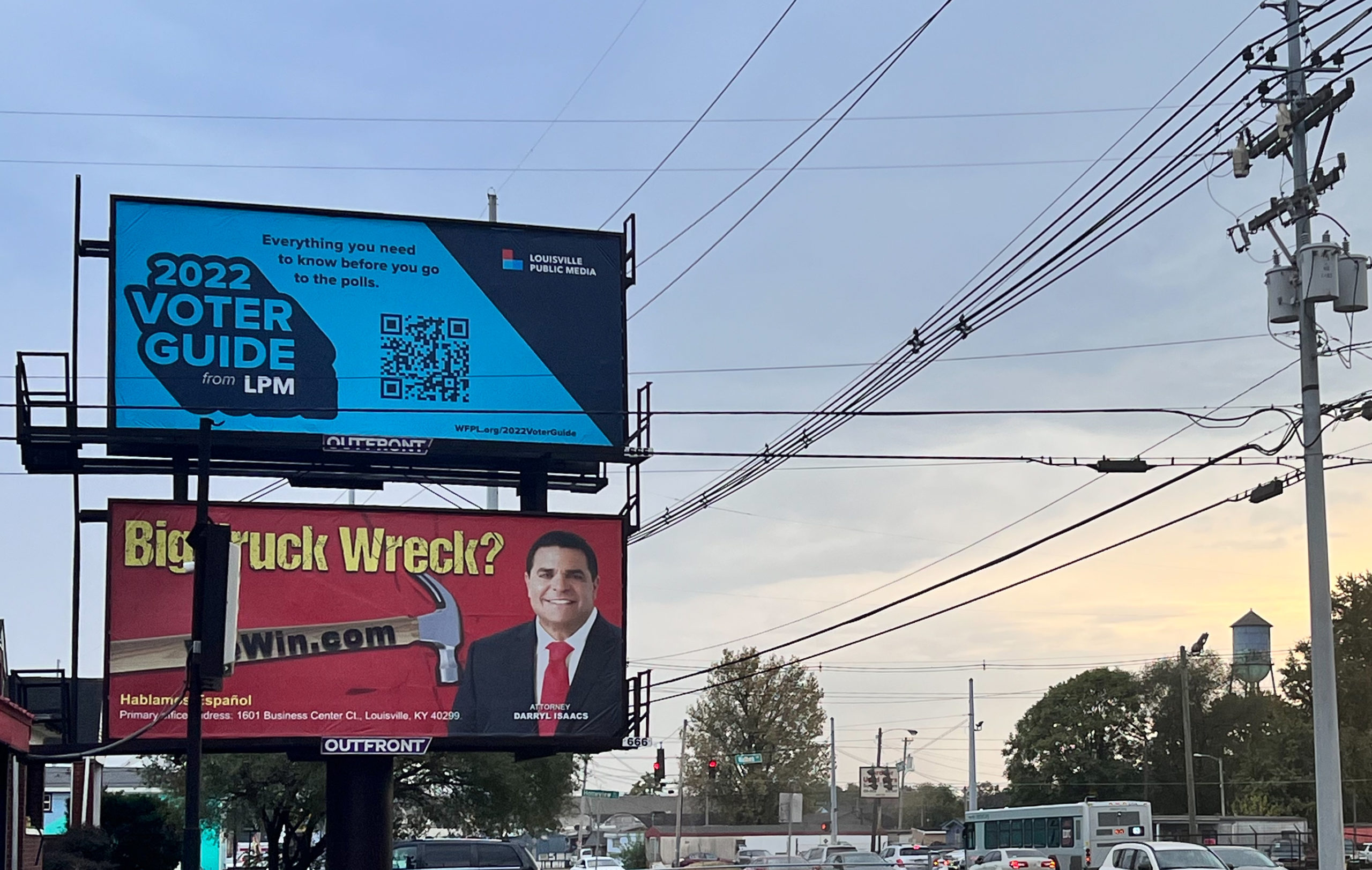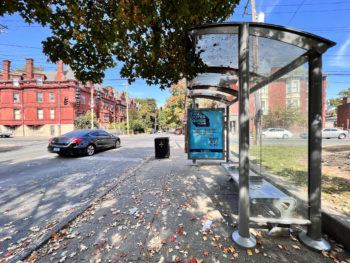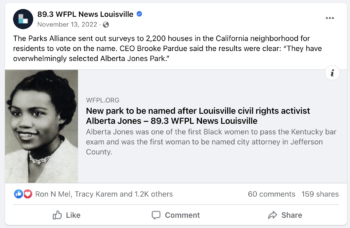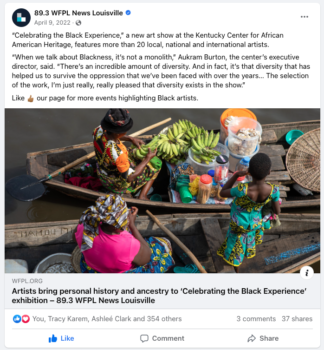The power of listening: How Louisville Public Media shifted from making news about Black people to making it for and with them
Ellen Oost and Gabrielle Jones, Louisville Public Media, Here’s an idea to steal and adapt: Understand your opportunities for audience growth through research, experimentation and listening. Change your reporting process to focus more on making news for and with local Black communities instead of just about them. At the same time, grow awareness through marketing and outreach, and leverage partnerships to expand your reach and understanding as well as to build trust.
Here’s an idea to steal and adapt: Understand your opportunities for audience growth through research, experimentation and listening. Change your reporting process to focus more on making news for and with local Black communities instead of just about them. At the same time, grow awareness through marketing and outreach, and leverage partnerships to expand your reach and understanding as well as to build trust. This is a series on Better News to a) showcase innovative/experimental ideas that emerge from the Knight-Lenfest Newsroom Initiative and b) share replicable tactics that benefit the news industry as a whole. This “win” comes from Ellen Oost, vice president of development and marketing, and Gabrielle Jones, vice president of content, both of Louisville Public Media (LPM). LPM participated in the UNC-Knight Foundation Tables Stakes program in 2021-22.
Question: What communities do you serve and what can you tell us about the history of your organization?
Answer: LPM is a public media outlet serving Louisville, Ky., online, on the radio, through podcasts and community events. We’re a little different from a lot of public radio outlets because we have three stations: WFPL News, WFPK Music and WUOL Classical.
We started in 1950 in the Louisville Free Public Library and became a 501(c)3 and community licensee in 1993.
We do fact-based reporting that is free from political and corporate influence, and we produce daily journalism online and through broadcast and digital audio. We are the NPR affiliate serving Greater Louisville and Southern Indiana. Additionally, we collaborate to serve a statewide audience through the Kentucky Public Radio Network and provide long-form watchdog reporting through the Kentucky Center for Investigative Reporting.
Our mission is to provide independent and courageous news, music and experiences that serve the needs and aspirations of our diverse community. Our vision is that, because of LPM’s work, more people in our community are seen and heard in media, feel connected and know how to take action.
LPM’s audience mirrors the demographics and politics of our local community, over-indexing for higher income households and those with a college degree. Just like our community, our audience is majority white. Right now, we don’t serve a representative number of Black Louisvillians — something we’re working to change.
Q: What problem were you trying to solve, and why was solving the problem strategically important for your organization?
A: We can’t continue to grow by serving only the “typical” public media audience. Not only is it counter to our public service mission, but to be sustainable long-term, we must add audience members. A larger, more diverse audience will drive membership conversion, enabling us to continue expanding our service to meet community needs. A big part of this is knowing that we must better serve Black and Latino residents in our community. We must spread awareness for our growing newsroom and especially our digital products to meet more people where they are and where they need us to be.

Bus shelter ad for LPM Voter Guide posted in West Louisville neighborhood. (Kirsten Pfalzgraf / Louisville Public Media)
We were already working toward this end when Breonna Taylor was killed in Louisville in 2020. We had invested in DE&I training and set up goals and accountability systems, including a source tracker and new professional development policies. We made changes to our recruitment and hiring practices to maximize the size and diversity of our candidate pools and put systems in place to help retain new employees. We began tracking staff demographics, comparing them to those of our community and creating a public annual report that shared our progress toward our goal to match the demographics of our community. We conducted a compensation equity study and implemented a more transparent and equitable advancement structure.
But a lot of our work had been internal, and Taylor’s killing and the protests that ensued added a sense of urgency around shifting that work more externally. Part of the process is awareness and trust building, and part has to do with the way we do our reporting and show up in traditionally underserved communities.
For many years, news organizations including ours have promoted racist narratives and upheld harmful systems. We are committed to doing work that is restorative and repairs harm, uplifting and including communities rather than exploiting them in coverage and programming, and leveraging our resources to help build trust.
We needed to better understand our audience growth opportunities through research, experimentation and listening. And we needed to change our reporting process to focus more on making news for and with local Black communities instead of just about them. At the same time, we needed to work to grow awareness through marketing and outreach, and leverage partnerships to expand our reach and understanding as well as to build trust.
Our primary goal is to become a more trusted local news source for more Black Louisvillians by telling stories for and with them. And while we made good progress during our year in the UNC-Knight Foundation Table Stakes program, this will be an ongoing goal for us for many years to come.
Q: How is this approach related to Table Stakes (e.g. one of the 7 Table Stakes and/or an outgrowth of the Knight-Lenfest initiative, etc.)?
A: The majority of our work relates directly to Table Stake No. 1 (“Serve targeted audiences with targeted content”) and Table Stake No. 2 (“Publish on the platforms used by your targeted audiences”).
Q: What strategies and research did you implement to help you better understand the problem?
A: In 2022, while we were in Table Stakes, we also participated in the Google News Initiative (GNI), where we sought to better understand the needs and news consumption habits of a specific group of Black Louisvillians: those living in our majority Black neighborhoods in Louisville’s West End.
Here, we’ll dive deeply into our research and product development.
Research
We held several focus groups with West End residents to learn more about how, when and why they consume local media, and what products or services are most important to them. These focus groups were held in a West End venue and participants were paid. We talked to Black residents, ages 21-65, who said they seek out local/community news at least once a month.
We used the information to refine current products — such as newsletters, events and podcasts — as well as develop a new video series. The focus groups were immensely helpful and brought home just how far we had to go in terms of awareness and trust, as well as reporting practices and how we share news made for this community.
Key takeaways:
- There was very low awareness of Louisville Public Media, NPR or WFPL
- Participants rarely listened to traditional radio news and get much of their news from social media (especially Facebook)
- They strongly preferred video content that can be viewed on a TV or smartphone
- They accused local news of being too negative and focused on problems, not solutions
- They cited many specific examples of news media getting their story wrong (almost every participant could cite an inaccuracy about them, someone close to them or their community)
- Participants want reporters who are embedded in the community and have a stake in its success. They are wary of reporters not connected to/in their communities
Despite working with a local research firm, recruiting for our focus groups turned out to be challenging. Local market research databases were not heavily sourced with residents from these communities.
Our research was designed to invite many of the same participants in our initial group to follow-up focus groups so that they could see what we created as a result of our previous conversations. We wanted to listen and then bring back potential solutions to see if we were hitting the mark.
Product development and refinement
In between focus groups, we built products to address the feedback we were getting. We developed and marketed new podcasts, produced a mailed version of our annual voter guide and created new video content for social media.
Facebook: Since we heard that Facebook was an important place for our content to be discovered, we started out by boosting a variety of reporting to our target audience to increase awareness and reach.
We invested nominally in paid marketing on the platforms. We selected stories about issues and subjects that predominantly impact Black people, as well as stories about subjects our focus groups directly told us they were interested in. Because Meta does not allow you to target people of a specific race with its advertising, we focused on the 10 ZIP codes with the highest percentage of Black Louisvillians, including West End neighborhoods.

Example of a Facebook post boosted to target zip codes that had high engagement. Screenshot from 89.3 WFPL.
In total, we boosted 36 posts using GNI funds for marketing. On average, each post reached more than 7,000 individuals and had nearly 700 engagements. The best performing post was for a new park to be named after Louisville civil rights activist Alberta Jones. Another post that performed extremely well was a photo essay by Iyabo “Mesa Pisa” Serikali featuring West Broadway (a street in West Louisville) and the longstanding buildings and corners that have been landmarks in the community.
The success of these posts supports what we heard in our research: the desire for more positive stories that uplift and celebrate the community.
Video: Since we had experimented with showing up where our target audience was and serving them topical content they said they wanted, we knew we also needed to give them the type of content they preferred. Video production is not a core competency of ours, so we worked with a local video contractor who was well-connected in the target neighborhoods. He worked alongside our news team to create six short videos highlighting life in West Louisville — from local business openings to community garden programs and academic enrichment programs.
On average, we spent less than $200 per video, but each reached more than 36,000 viewers, with an average of more than 12,000 through-plays of more than 30 seconds per video. Considering our original goal was to reach 1,000 people with each video, it seemed to be working.
Podcasts: We also wanted to show up in person and in our podcasts — since those are both core competencies of ours and also important to our target audience. From social to print, we marketed LPM podcasts led by Black hosts and designed for Black Louisvillians. We chose two podcasts that showcase Black achievement, joy and other topics indicated of interest in our research: Words for the People and Sprinkle Sparkle. We marked the podcasts on social media and partnered with new print partners who focus on this target audience. We wanted our name and offerings to begin showing up where these folks are, so that we can begin building the awareness and trust necessary for a long-term relationship. The podcasts launched in April and September, respectively, and were downloaded a total of 20,000 times in 2022.
Events: We held an event in partnership with national NPR show 1A in a West End park where we focused on lifting up the voices of young people in our community as they shared their roles in creating change. We also set up tables at several West End community events, incentivizing follows on social media and email registrations with various giveaways. Our newsroom leadership is working with reporters to set accountability measures for newsroom staff to regularly attend events and interview sources in the West End and other underserved Louisville neighborhoods.
Voter guide: We used our annual voter guide as an opportunity to grow awareness for the public service we provide. Using outdoor boards and direct mail, we targeted key neighborhoods to spread the word about our guide and begin associating this resource with LPM. The interactive guide was digital, but we mailed more 7,200 truncated copies of the guide to West Louisville voters, customized to their voting districts. We included a note about LPM and asked for feedback about it.
During our final focus group we were able to show a sample of the guide, and it was praised for providing “short, helpful, non-manipulative summaries of the candidates and their views.”
Rounding out the research
Because our focus groups surveyed a relatively small population, we wanted to also get feedback from a wider swath of our target audience.
We created a list from qualifying current email subscribers and also purchased a list through Survey Monkey to do a companion digital survey. We included article excerpts, played podcast audio and asked questions about local news consumption and awareness of LPM.
We had 166 people respond and the results mirrored that of our in-person focus groups. Around 60% of respondents indicated they were not familiar with LPM and its brands (which was an improvement on the in-person focus groups, although slightly skewed since about 30 of the respondents were from our own list), and over 50% responded positively to the podcasts and news stories we shared.
Since this survey was done at the end of 2022, after eight months of our efforts, we’d like to think that the improved awareness might be attributable to the marketing work we’d been doing, but there’s no way to prove that.
Q: What worked?
A: We created targeted content for our target audience. We developed a video series (preferred medium) based on what we learned was topically of interest to our target audience. We highlighted Black joy and achievement, as well as struggles. We shared our work on social media (Instagram reels and Facebook stories), where they said they’d be most likely to see it.

Example Facebook post boosted to target zip codes with call to follow for more. Screenshot from 89.3 WFPL.
The videos averaged 12,300 through-plays of :30 or more and our videos from this series have been viewed more than 200,000 times. Comments from our final focus group included, “I love seeing us, meaning Black and brown people, being represented in a positive light,” and “I love that it’s positive, informative and collaborative.”
We hope that these are positive indicators toward our goal that more Black Louisvillians feel seen and heard as a result of our work.
We also created a digital voter guide and distributed and marketed it to our target audience in order to create exposure to typical LPM content in an effort to build awareness, trust and trial. We used outdoor ad boards and bus shelters in key neighborhoods and had a QR code to track mobile interactions with them.
We purchased a list of registered voters in West End ZIP codes and mailed copies of the guide to homes and served accompanying IP-targeted digital ads to the guide. The guide received over 35,000 unique pageviews between publication and Election Day with an average time on page of nearly six minutes.
The digital ads were clicked 327 times and the outdoor QR codes were scanned more than 150 times. Of the 7,200 copies we mailed, 27 unique individuals used the QR code to check out the full guide and 28 provided feedback.
Q: What didn’t work?
A: It was really hard to find people to participate in our research.
As previously mentioned, local research firms did not have a large database of our target audience from which to recruit from and they had very few email addresses to reach them. The digital survey was easier to target, using Survey Monkey’s targeting tools, but we also tried a geotargeting digital ad promoting our digital survey in our target ZIP codes — specifically including the list that received our mailed voter guide.
The digital ad asked for survey participants and promoted $100 gift cards awarded to five survey participants. The ads got a lot of clicks, but no one from these ads actually filled out the survey. Display ads work to varying degrees, and it might have been that the gift card offer made them look like spam.
Q: What happened that you didn’t expect?
A: We knew we had low awareness with this target audience. And we knew that trust would be an issue.
But we had already been focusing editorially on serving this audience intentionally, so we didn’t realize the degree to which these challenges would persist. A very high percentage of focus group participants shared that they or someone close to them had personally been mischaracterized in a news story or were victims of another inaccuracy.
Many of them likened “the media” to the police in terms of their trust and comfort. We learned right away that we needed to differentiate ourselves, but also that we had more community engagement work to do.
When we started this project, we thought that our product development might be centered around a new newsletter or podcast. We did not go into this thinking we would be producing videos for social media. But we heard loud and clear that it was a place we needed to be to grow awareness and engagement with our target audience. That’s where we centered our work and that’s where we saw great results.
Q: What would you do differently now? What did you learn?
A: We learned so much!
If we started this all over again, we’d build sustainability into new product development on the front end. When we piloted the video series, our approach was to see if it works and then fund it. Now we have a successful product and are having to get creative around how to keep it going.
We’d design a way to expose people in the newsroom to our focus group’s feedback. We had just three or four participants from our team in each of the groups so that it felt like the space was mostly for the participants. This was a key part of us getting the clear, honest feedback participants gave us, but it also meant we were translating what we heard to our larger team and they were sometimes skeptical. We probably could’ve gotten sustained buy-in faster if a larger group of team members were able to hear the feedback first-hand.
Another thing we learned was that just introducing our team to the community is not enough. We experimented with some online Q&As to share more about our individual reporters’ work and interests with wide swaths of our community.
These were web articles we targeted to Black communities via boosted social posts — they did not perform well. We heard from our focus group participants that these would be better if the reporters featured were pictured in places the audience recognized and felt ownership of in our community, not just at the reporter’s desk or in their own home.
Essentially, people were only interested in learning about our team if it was immediately and obviously apparent how our team was connected to them or could impact their daily lives for the better. And just saying “I report important news in a balanced way” was not enough.
Most importantly, the value of listening to the community about its needs and desires was strongly reinforced for us by this process.
As we mentioned earlier, we went into this work thinking an email or podcast would be our best play, and our community made it very clear that was an incorrect assumption. We were wise enough to know not to move ahead with those plans without community feedback. But this process really reinforced for us that the best approach is a design-thinking that starts with a community need. People just can’t be wrong about their own opinions and desires. (Full stop. That’s the sentence.)
Q: What advice would you give to others who try to do this?
A: Be open to what you will learn from the research. It’s not always what you want to hear.
It takes a lot of work (and money) to build trust and awareness. Make sure you properly resource this work. Focus groups can be expensive, but there are digital tools (like Survey Monkey and Google Forms) that can be a great place to start without a big budget, but in our experience the feedback was not as robust and comprehensive.
Although we reached our largest audiences online during this experiment, we also had to lean on a lot of traditional marketing tools like direct mail, outdoor boards, print ads and in-person events to create broader awareness.
Even when you have a well-defined target audience, it can be hard to reach them. The amount of investment required to get this amount of information from an audience that is disconnected from us is large. We will need consistent layered marketing and targeted engagement to make progress.
Q: Is there anything else you’d like to add?
A: We recently completed a new strategic plan and were adamant that our goal to better serve Black communities be included in that work.
This work through Table Stakes and GNI informed a lot of our plan and is central to our new vision statement to ensure that more people in our community are seen and heard in media, feel connected and know how to take action.
This will require bringing more people into our newsgathering and building relationships and collective experiences through local news. We have to do the work to identify and close equity gaps through internal policies and culture as well as fair coverage. We have to push ourselves to do what is hard and to do it continuously.